
Charles Upham Shepard (born in Little Compton, Rhode Island, 29 June 1804; died in Charleston, South Carolina, 1 May 1886) was an American mineralogist. [1]

Charles Upham Shepard (born in Little Compton, Rhode Island, 29 June 1804; died in Charleston, South Carolina, 1 May 1886) was an American mineralogist. [1]
He graduated from Amherst College in 1824, [2] and spent a year in Cambridge, Massachusetts, studying botany and mineralogy with Thomas Nuttall, and at the same time gave instructed on these topics in Boston. The study of mineralogy led to his preparation of papers on that subject which he sent to the American Journal of Science , and in this manner he became acquainted with Benjamin Silliman, the elder. He was invited in 1827 to become Silliman's assistant, and continued so until 1831. Meanwhile, for a year he was curator of Franklin Hall, an institution that was established by James Brewster in New Haven, Connecticut, for popular lectures on scientific subjects to mechanics.
In 1830 he was appointed lecturer on natural history at Yale University, and held that place until 1847. He was associated with Silliman in the scientific examination of the culture and manufacture of sugar that was undertaken by the latter at the special request of the secretary of the treasury; and the southern states, particularly Louisiana and Georgia, were assigned to him to report upon. From 1834 until 1861, he filled the chair of chemistry of the Medical College of South Carolina in Charleston. He relinquished the position at the beginning of the Civil War, but in 1865, upon the urgent invitation of his former colleagues, he resumed his duties for a few years.
While in Charleston he discovered rich deposits of phosphate of lime in the immediate vicinity of that city. Their great value in agriculture and subsequent use in the manufacture of superphosphate fertilizers proved an important addition to the chemical industries of South Carolina. In 1845 he was chosen professor of chemistry and natural history in Amherst, which chair was divided in 1852, and he continued to deliver the lectures on natural history until 1877, when he was made professor emeritus.
He was associated in 1835 with James G. Percival in the geological survey of Connecticut, and throughout his life he was actively engaged in the study of mineralogy. He announced in 1835 his discovery of his first new species of microlite, that of warwickite in 1838, that of danburite in 1839, and he afterward described many other new minerals until shortly before his death.
Shepard acquired a large collection of minerals, which at one time was unsurpassed in this country, and which in 1877 was purchased by Amherst College, but five years later was partially destroyed by fire. [3] Early in life, he began the study and collection of meteorites, and his cabinet, long the largest in the country, likewise became the property of Amherst. His papers on this subject, from 1829 till 1882, were nearly forty in number and appeared chiefly in the American Journal of Science.
Shepard received an honorary M.D. degree from Dartmouth College in 1836, [4] and honorary LL.D. from Amherst in 1857. He was a member of many American and foreign societies, including the Imperial Society of Natural Science in St. Petersburg, the Royal Society of Göttingen, and the Society of Natural Sciences in Vienna.
In addition to his many papers and reports on mines in the United States, he published:
His son, also named Charles Upham Shepard (born in New Haven, Connecticut, 4 October 1842), was also a chemist. He graduated from Yale in 1863 [5] and at the University of Göttingen in 1867, with the degree of M.D. On his return, he was appointed professor of chemistry in the Medical College of the state of South Carolina, which chair he held until 1883. Afterward, he has devoted himself entirely to the practice of analytical chemistry. The younger Shepard was active in developing the chemical resources of South Carolina, and paid special attention to the nature and composition of the phosphate deposits of that state.
In 1887, he presented the second cabinet of minerals that was left by his father, numbering more than 10,000 specimens, to the collections at Amherst, and his cabinet of representatives of more than 200 different meteorites has been deposited in the Smithsonian Institution in Washington, D.C.
This article needs additional citations for verification .(April 2014) |
{{cite book}}: CS1 maint: location missing publisher (link)
Columbite, also called niobite, niobite-tantalite and columbate, of general chemical formula (FeII,MnII)Nb2O6, is a black mineral group that is an ore of niobium. It has a submetallic luster and a high density and is a niobate of iron and manganese. This mineral group was first found in Haddam, Connecticut, in the United States. It forms a series with the tantalum-dominant analogue ferrotantalite and one with the manganese-dominant analogue manganocolumbite. The iron-rich member of the columbite group is ferrocolumbite. Some tin and tungsten may be present in the mineral. Yttrocolumbite is the yttrium-rich columbite with the formula (Y,U,Fe)(Nb,Ta)O
4. It is a radioactive mineral found in Mozambique.

Benjamin Silliman was an early American chemist and science educator. He was one of the first American professors of science, at Yale College, the first person to use the process of fractional distillation in America, and a founder of the American Journal of Science, the oldest continuously published scientific journal in the United States.

Othniel Charles Marsh was an American professor of paleontology at Yale College and president of the National Academy of Sciences. He was one of the preeminent scientists in the field of paleontology. Among his legacies are the discovery or description of dozens of new species and theories on the origins of birds.

Daniel Coit Gilman was an American educator and academic. Gilman was instrumental in founding the Sheffield Scientific School at Yale College, and subsequently served as the second president of the University of California, Berkeley, as the first president of Johns Hopkins University, and as founding president of the Carnegie Institution.
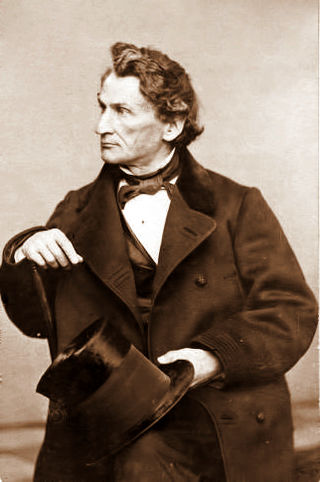
James Dwight DanaFRS FRSE was an American geologist, mineralogist, volcanologist, and zoologist. He made pioneering studies of mountain-building, volcanic activity, and the origin and structure of continents and oceans around the world.

Denison Olmsted was an American physicist and astronomer. Professor Olmsted is credited with giving birth to meteor science after the 1833 Leonid meteor shower over North America spurred him to study this phenomenon.

William Phipps Blake was an American geologist, mining consultant, and educator. Among his best known contributions include being the first college trained chemist to work full-time for a United States chemical manufacturer (1850), and serving as a geologist with the Pacific Railroad Survey of the Far West (1853–1856), where he observed and detailed a theory on erosion by wind-blown sand on the geologic formations of southern California, one of his many scientific contributions. He started several western mining enterprises that were premature, including a mining magazine in the 1850s and the first school of mines in the Far West in 1864.
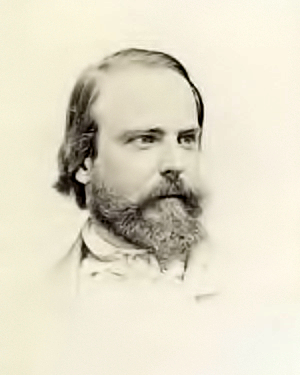
John Lawrence Smith was an American chemist and mineralogist.
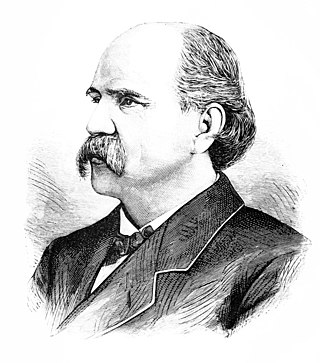
George Jarvis Brush was an American mineralogist and academic administrator who spent most of his career at Yale University in the Sheffield Scientific School.

Bertram Borden Boltwood was an American pioneer of radiochemistry.
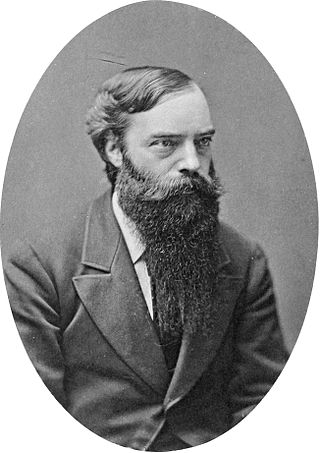
Arthur Williams Wright was an American physicist. Wright spent most of his scientific career at Yale University, where he received the first science Ph.D. awarded outside of Europe. His research, which ranged from electricity to astronomy, produced the first X-ray image and experimented with Röntgen rays. He also proved instrumental in securing funding for the first dedicated physics laboratory building in the United States, the Sloane Physical Laboratory.
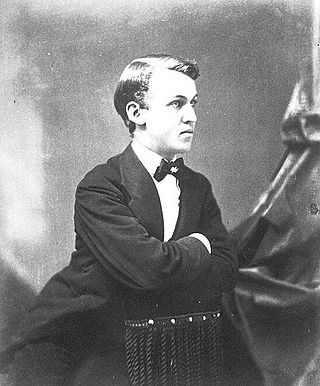
Edward Salisbury Dana was an American mineralogist and physicist. He made important contributions to the study of minerals, especially in the field of crystallography.

George Park Fisher was an American theologian and historian who was noted as a teacher and a prolific writer.
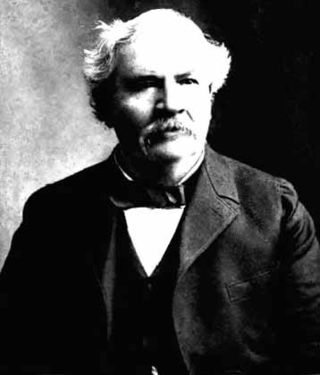
Charles Anthony Goessmann, known in his native German as Karl Anton Gößmann, was a Massachusetts agricultural and food chemist.

The Weston meteorite is an H4 ordinary chondrite meteorite which fell to earth above the town of Weston, Connecticut on the morning of December 14, 1807.
James Freeman Dana was an American chemist.
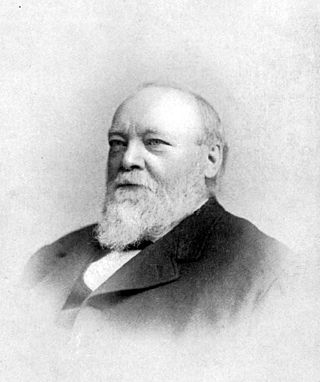
Frederick Augustus Ludwig Karl Wilhelm Genth was a German-American chemist, specializing in analytical chemistry and mineralogy.

Henry Bradford Nason was a United States chemist.
John Maley was an American explorer and a contemporary of Meriwether Lewis, William Clark and Zebulon Pike. In 1815, he wrote a journal of his travels through the trans-Mississippi West in the early 19th century.
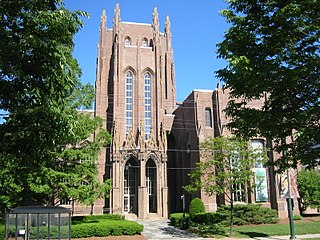
The Peabody Museum of Natural History at Yale University is one of the oldest, largest, and most prolific university natural history museums in the world. It was founded by the philanthropist George Peabody in 1866 at the behest of his nephew Othniel Charles Marsh, an early paleontologist. The museum is best known for the Great Hall of Dinosaurs, which includes a mounted juvenile Brontosaurus and the 110-foot-long (34 m) mural The Age of Reptiles. The museum also has permanent exhibits dedicated to human and mammal evolution; wildlife dioramas; Egyptian artifacts; local birds and minerals; and Native Americans of Connecticut.